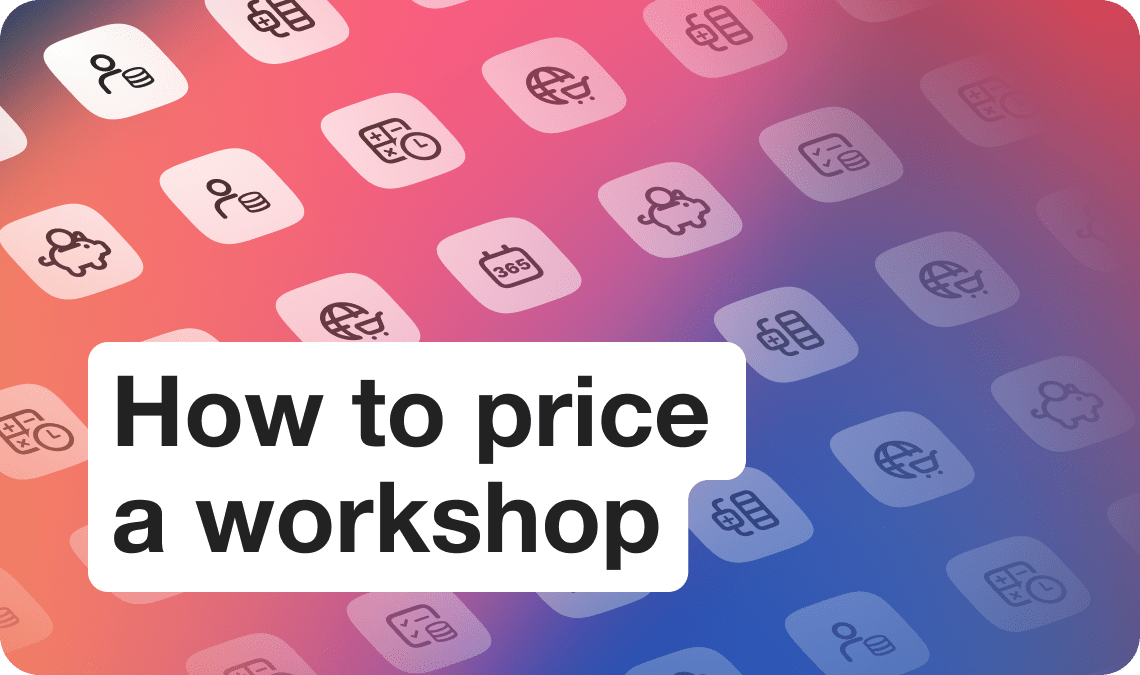
How to price a workshop
Workshop pricing can catch many trainers between a rock and a hard place. Setting the price too high may result in losing potential clients. And deliberately lowering the bar means underestimating your own expertise which is not easy to gain.
So, how to find the middle ground between these two worries and calculate a fair price? In this guide, we will go through the process of workshop pricing step by step, find the way to calculate or analyze each one, and see how successful trainers and training companies handle this matter.
We sincerely thank Lili David (Sociocracy 3.0), David Marti (European Scrum), Pit Zurkichen (Lean Change Management), Anne Meeussen (The Campus), Lisette Sutherland (Collaboration Superpowers), Agnes Molnar (Search Explained), and Paula Magalhaes (Agile Thinkers) Sohrab Salimi (Scrum Academy) for sharing their professional insights about this topic and helping us bring more value to the article.
Get the FREE Workshop Pricing Checklist and receive tips for your training business once a week
Workshop pricing strategies
There are several strategies applicable to workshop pricing. Each one takes on the matter from a different perspective
Cost-plus pricing strategy includes the cost of preparing and running a workshop and markup, or the percentage of the profit you want to make. For example, if you aim at 30% profit, you add 30% to a workshop cost to get the final price. This strategy is best suited for one-time workshops. It allows you to cover all costs and get the profit for sure. The main question here is what percentage would be fair both for you and your attendees.
Hourly-based pricing strategy prices time required to deliver a service. It comes especially helpful for consulting because you and your client can clearly estimate the number of hours it takes. But it also works for other training services as all of them take time to prepare and deliver.
Value-based pricing strategy handles workshop pricing from the position of the target audience — how much they are willing and able to pay for the skills and knowledge you are offering them. This strategy leverages the most important parameter of any workshop — its value. But it’s also the most difficult one to grasp.
Competitive pricing strategy enables you to set your prices in a range similar to your competitors’ offers. It’s useful for any type of workshop and can serve as a reference point for those trainers who have just started and don’t have a clear vision of what to charge for their training sessions.
Combining several strategies might be the best solution. Each of these strategies focuses on one aspect, but in reality, pricing intertwines with many factors: time and efforts, trainer's expertise, target audience, and the situation on the market. By employing different strategies you can be sure that no aspect of your workshop would go underpriced.
Workshop pricing formula
Workshop price can be calculated in 7 steps that involve all strategies listed above. The first four steps are actual calculations and the last three help you make adjustments.
- Step 1: Build an annual plan
- Step 2: Calculate the time cost
- Step 3: Calculate monetary expenses
- Step 4: Calculate a cost per person
- Step 5: Run competitive analysis
- Step 6: Define the value
- Step 7: Adjust to the audience’s income
- Set up the final price
- Tips and recommendations
These steps are not a must and you might skip or change some of them depending on the situation. But it’s important to at least remember about them as they take all main business aspects into account.

Step 1: Build an annual plan
If the training business is your only source of income, deciding just the price of the next workshop won’t be enough. You need to see how profit from it fits into a bigger picture — annual income and training schedule. Otherwise, you might end up in red numbers.
Desired income
Answer the following questions for yourself:
Conclusion:
Define our desired annual income: enough for you to live comfortably and for your business to prosper.
Training schedule
Make a rough estimate of how many events you plan to hold within a year. Remember that there are busy seasons when people are more inclined to spend money on learning and quiet periods when the chances to fill seats are low. Schedule your workshops with this consideration in mind.
Getting accurate numbers might be impossible, but having even a broad outline is better than running workshops randomly and just hoping for the best.

We have a rough calculation of how many courses/year with minimum participants we are able/ willing to deliver and see if that feels good enough.

Lili David • Co-developer of Sociocracy 3.0
Conclusion:
With a schedule at hand, you will get a rough understanding of how much profit you can make from planned workshops.
Number of working hours
Calculate the approximate number of working hours per year. Not only will you need this number for the upcoming calculations, it will also help you make up a working schedule if you haven’t done it yet.
Tip: There are a number of days when you won’t be working (vacations, national holidays), but if you plan to make them payable, you need to include them in your calculations.
Conclusion:
Working hours/day × working days/week × 52 (the number of weeks/year) = number of working hours per year.
Need a calculator? Click here

Step 2: Calculate time cost
Start with calculating the workshop cost, in terms of both time and money. These are the expenses you need to cover.
Hourly rate
The simplest way to price your time is to use an hourly rate. To calculate it, you will need two numbers: your annual income and the number of working hours per year.
Conclusion:
Annual income ÷ number of working hours per year = hourly rate.
Preparation time
There are two stages of preparation: creating a workshop and organizing each event.
Creation time includes research and structuring the data to develop a workshop itself. It plays a big role in the events that you do not plan to repeat. Covering all costs is not only logical but necessary in this case.
If a workshop is meant to be presented multiple times, efforts spent on creation will pay off after several sessions anyway. Excluding this factor from calculations will lower the price and a workshop will become available for more students. In the long term, it will lead to a higher profit.
And some workshops keep being developed and changed over time so calculating the time spent on this process is next to impossible.

I’ve spent 10 years developing the “Work Together Anywhere” workshop. It’s countless hours, countless iterations. Hundreds of hours of doing it.

Lisette Sutherland • Director of CS
Organizational matters usually imply preparation for a particular session: running a promotion, getting materials ready, setting up equipment, and preparing a room. At this point, the type of training will matter: public workshop or in-company session.
With a public workshop, you have to do all organizational tasks by yourself: set up accounts, rent a room, order catering, etc. But you will most likely present your workshop as-is, without making any changes to it.
When you are asked to run a private training session, the situation reverses. Most of the organizational work is done by your client and you know exactly how many people you will work with. However, there is a chance that you will have to make corrections to your workshop program to respond to their needs. And it should be reflected in pricing.

For in-company training, we have some more aspects to think about:
- Is it an 'off the shelf' training or does it need to be customized to our customers' desires?
- Is it just one session or will it return on a regular basis?
- Is it a new customer or do we have a sustainable relationship with them?

Anne Meeussen • Event coordinator at The Campus
Conclusion:
Number of hours for preparation × hourly rate = cost of preparation time.
Workshop duration
If pricing time for preparation is optional, duration absolutely needs to be taken into consideration. It’s what your students see and it’s where all your preparations pay off.
Conclusion:
Event duration in hours × hourly rate = cost of event duration.

A main driver is the onsite vs. online aspect and of course the duration of the training

Pit Zurkichen • Founder at agilist

Step 3: Calculate monetary expenses
Expenses can differ greatly depending on workshop location — online or onsite.
Any type of training usually involves the following expenses:
On-site training takes more to be prepared:
It would be nice to plan and estimate all the expenses before you get down to designing a workshop itself.
If you realize that the cost is too high for your target audience, think if you can compromise on something without lowering the overall quality. For example, choose online instead of an actual location or change date and time.
Tip: Want to reduce time and resources spent on organizing a workshop? Use a training management system like Workshop Butler. Learn more
Conclusion:
All expenses combined together = monetary cost of a workshop.

Step 4: Calculate cost per person
To be able to compare your price to your competitors’ offers or to understand the affordability for your target audience, you will have to calculate a cost per one ticket.
For this, you need two numbers: the total cost of your workshop and the number of students you expect to attend.
Total cost
All those costs you have calculated can now give you the full picture of how much your workshop costs in total. This number will serve as a starting point for setting up the final price.
Conclusion:
Cost of preparation time (optionally) + cost of duration + monetary costs = total cost of your workshop.
Number of attendees
Unless you are running a private workshop for a set group, predicting the number of students who will attend it can be tricky.
Still you need to determine for yourself the minimum number of participants. After the final ticket price is decided, you can check it against your annual plan and see if the profit you will make even with the minimum number of attendees will be enough.
Tip: You can always run a special discount that might drive more participants to your workshop. Consider the profit from such discounts when calculating overall possible profit from an event.

Sometimes the course does not sell well. I tried to lower the prices, e.g. “last minute” or “special discount.

Agnes Molnar • Founder at Search Explained
Cost per person
Using the lowest possible number of attendees in your calculations is a guarantee that a workshop will pay off in any case.
Conclusion:
Total cost of a workshop ÷ minimum number of participants you expect = cost per person.
Need a calculator? Click here

We calculate the minimum, ideal and the maximum number of participants needed to run the course e.g. 12, 18, and 21 (it varies from course to course). Usually, the Early Bird price is calculated based on minimum attendance, normal price according to ideal no of attendees.

Lili David • Co-developer of Sociocracy 3.0

Step 5: Run competitive analysis
Calculating the cost of a workshop is relatively easy as you operate with real numbers. Once you get the cost per person, you can start adjusting it to your audience’s needs and situation on the market.
First, take a look at what your competitors charge for similar services. It will give you some tangible numbers too. Researching the competitors’ pricing is an important step for two main reasons.
First — to be able to compete with them, it’s better to adjust your price to the average on the market.
Second — it helps you see how you are different from your competitors.

I also do some research to check what others charge for similar courses, but this is just a minor factor for me. “Similar” means similar duration, similar efforts, similar process during the training, similar outcomes, etc. If I cannot find anything that is “similar” enough, I find as many as possible that are “close to similar”, and check their prices. Then I identify the differences, and make decisions if these are relevant or not, if these increase the value of the course or not, etc.

Agnes Molnar • Founder at Search Explained
The average price on the market
Research your direct competitors and their prices. Direct competitors are those who offer the same services and to the same target audience as you.
You can find them and their pricing in several ways:
- Check Eventbrite or other platforms for hosting events
- Check freelance platforms like Upwork
- Search through LinkedIn or Facebook to find companies with similar services
- Manually search for them in Google using keywords associated with your business.
Tip: If you don’t have many ideas on what keywords to search for, use Google Keywords Planner. It can help you find new keywords to run in Google search. It will also show you what keywords your competitors’ websites are ranked for so you could check these suggestions in Google too. Read this guide to learn how to use the Planner.
Conclusion:
Define the price range: make a list of the services your direct competitors provide and their pricing.
Make the relevant arrangements to the cost of your workshop to put it in a similar range.

It should be in an appropriate range such as ±20%.

Pit Zurkichen • Founder at agilist

We also look at similar courses from our network and compare the number of hours /course vs the price they offer. We usually aim for similar or lower prices.

Lili David • Co-developer of Sociocracy 3.0
Difference between you and competitors
The most important conclusion you should reach when researching your competitors is what stands you apart from them.
Can you offer something that others don’t? If you have a unique approach that can really make a difference for your students, you can set a higher price. Just make sure to explicitly convey this difference and its value when promoting your workshop.
Are your and your competitors’ positions on the market the same? People and companies operate different budgets and offer different ranges of services. Some of them can sell their workshops at a lower price because they will compensate for it with profit from other sources. Or, on the contrary, they can ask for a higher price because of their established reputation.
Take this into account, while researching your competitors.

We might consider the competitors price’s depending on the situation. For example in Scrum Alliances courses our competitors work with low budget trainers and we are not. They are able to offer big quantity discounts and we are not.

Paula Magalhaes • Head of Business Development at Agile Thinkers
Conclusion:
Think how the difference between your and your competitors’ offers and situations can change your price.

Step 6: Define the value
Trying to determine a workshop value is where the real difficulty starts. There won’t be any numbers you can rely on. What you need is a good knowledge of your audience and their needs.
Workshop value
To grasp the real value of a workshop, think about what problems it addresses, how urgent these problems are, and what your students will be able to do about these problems after attending your event.

Once I’ve created the workshop, what I think about is how much value does it offer to people. How much would people be willing to pay for this. What value do I think it is.

Lisette Sutherland • Director of CS
How engaged will your students be?
Will your students have to figure out for themselves what to do with the knowledge they gained? Or will you show its application through tasks, case studies, and active discussions? Practical tasks are more effective than simply listening to a speaker. They raise the chances to learn things and the value of your workshop.
What will it affect?
How much will this workshop help them and how soon will they see an effect? Will it help them work faster and coordinate more efficiently? Or can they apply this knowledge to directly increase the profit?
Are there any bonuses?
A prospect to receive something else apart from the main program can increase the value of a workshop as well. It can be an ebook with tips and strategies, a game, or even consulting services if you are working with a small audience.
Are there any post-event activities?
Will the participants be left on their own after the workshop ends or will you provide some kind of a follow-up? You can simply check how the knowledge sinks in or invite them to a special community — it will make learning more effective and allow your students to be sure they can ask questions while trying to apply the knowledge you gave them.
Tip: Don’t know where to start with a community for your students? Listen to our podcast to learn how Agile Thinkers, Epic Agility, and tryScrum manage their online communities.
What will be the level of participants?
Are your students just starting with the topic of your workshop? Or are they working with it for a long time? Teaching the ropes to beginners and discussing complex matters with experienced professionals call for a different level of preparation from a trainer. The more a workshop goes into detail, the more expensive it becomes.

More advanced means more expensive since the trainer invests more in achieving that level. More specific and rare courses are more expensive.

Paula Magalhaes • Head of Business Development at Agile Thinkers
Perceived value
Your students also have some notion in their head how much they are ready to pay for a certain knowledge or skill. Perceived value is how much your product or service should cost from the perspective of your customers.

For “Work Together Anywhere”, I do think it’s worth more than 295 euros. [...] However people are not expecting the quality that I think Collaboration Superpowers offers. So I settle it to 295. But it really is worth more than that.

Lisette Sutherland • Director of CS
If the topic of your workshop is in high demand and everyone is eager to learn about it, the perceived value grows because people expect to be asked a high price for a high-demand topic. The same goes for the topics scarcely presented on the market. People will see such workshops as more valuable as there are not so many chances to participate in them.

Some trainers are more expensive if their knowledge is more specific and/or rare.

Anne Meeussen • Event coordinator at The Campus
To raise the perceived value of your workshop, you need to clearly demonstrate your expertise.
- Show certificates to let people know that your knowledge is accredited.
- Tell about your degree to demonstrate that you have spent a lot of time studying the things you are talking about.
- Mention books if you have written any to give your customers an opportunity to see your expertise for themselves.
- Attach a link to a blog. People might not have time to check out a book, but they can quickly look through a series of blog articles.
- Invite to listen to a podcast that you host to show not only your knowledge but presentation skills as well.
- Tell about your working experience to back up things you are going to talk about with real-life examples.
- Share testimonials from your previous workshops because feedback is one of the most convincing tools on the market. And keep collecting more evaluations from each of your events. Tip: Do not forget to ask your attendees’ permission to use their feedback as a testimonial.
Tip: Workshop Butler allows you to easily add any of this information to a trainer profile, and then display on your website. Evaluations can be instantly converted into testimonials, with the student’s consent collected beforehand.
Conclusion:
Think how much value your workshop provides and how your potential clients can understand this value, then adjust your price accordingly.
Underpricing
Perceived value is the reason why you shouldn't lower a price too much. It can be tempting because it seems that this way you can beat the competitors and become more available and attractive to your clients.
But it can actually turn against you. If people see the price way below their expectations they might think that the quality is low too or that it's something different than they need.
Deliberately underpricing your services is definitely not recommended.

Don’t go too low. In the Entrepreneur On Fire when I was listening to that podcast, they were just saying: “Don’t be too cheap. People are suspicious when it’s too cheap.” When I went from 49 euros to 490 euros, I sold more workshops.

Lisette Sutherland • Director of CS

Step 7: Adjust to the audience’s income
You might know exactly who your ideal student is and offer extremely valuable knowledge for them. But this information will be pointless if the ticket price is beyond their paying capacity.
For a private workshop, take into account your client’s scale of operation. If it’s a small business, they will hardly spend large sums of money on training.
In case you are running a public workshop and it is aimed at people of a certain profession, you can try to find out their average income:
- Use manual Google search
- Check job hunting sites like Indeed. The job descriptions there often include a salary offer
- Use special websites that conduct salary research like Payscale.
Compare the ticket price you are going to set with their salary and see how likely they will purchase it. Ask yourself: Would I buy a ticket if I were to receive this salary?
If finding out an average income turns out to be difficult, you can try a more personal approach like making the price discussable. It might be time-consuming but it will help you build a loyal customer base and clearly understand needs and possibilities of your students.

We add this to all course descriptions: If you wish to participate in this course and the fee is beyond your means or the value you place on it, please contact us to explore how your attendance may still be possible. We wish to ensure that cost is no barrier to attending Sociocracy 3.0 courses....Sometimes we have 3 people requesting to pay much less, which significantly lowers the income/course. When this happens, we move one of them to a different course to spread the cost. But usually we don't have more than 1-2 requests for a lower price/course.

Lili David • Co-developer of Sociocracy 3.0
Tip: If you are going to run your workshop in different countries, keep regional differences in mind. The income and subsequently prices won’t be the same everywhere so you need to adjust it accordingly.

Prices are “not the same Mexico to Germany”

David Marti • Founder at European Scrum
Conclusion:
Make your workshop affordable for your audience: correct the price with their income in mind.

Set up the final price
It’s almost impossible to price a workshop right off the bat, especially for someone who has just started in this field. What can help is breaking the process into smaller steps and working out the price by analyzing each aspect separately:
- Time spent on preparing a workshop
- Workshop duration
- Cost of materials
- The average price on the market
- The uniqueness of your offer
- Value of your workshop for your audience
- Your ability to show this value
- Perceived value
- Paying capabilities of your target audience.
Remember that you will also have to include sales tax into each ticket price and possibly, a fee to a payment provider (e.g. Stripe or PayPal.
Tip: Tired of endless paperwork and calculations? Workshop Butler will calculate a tax for your tickets automatically and make a breakdown of each payment for you: tax, fees, and net profit.
Read more
Don’t be afraid to ask for a fair price
After every number has been calculated and all considerations and adjustments have been made, there is only one thing left. Ask yourself if the price feels right for you. An answer to this question will come easier as you get more experience in what you are doing. Over time, if you learn to trust this gut feeling, it might become the decisive factor in setting a price.

We check how the prices look and make adjustments (e.g. one might seem too small or too big, we round up the numbers and check if it feels right). I'd say the final decision is on gut feeling.

Lili David • Co-developer of Sociocracy 3.0

Tips and recommendations
Keep the price flexible
The prices you set are not carved in stone. There is a high chance that you will have to correct them and not just once. As you learn your audience, you might notice mistakes in your calculations. It’s only natural to take them into account and change pricing a little bit.
Do not forget about various discounts and price groups that can help you accommodate the needs of your students and attract more people to your workshops. Another reason why you can change prices is that you will be growing as a facilitator and be able to offer more value. You will gain reputation, collect testimonials, and, most importantly, become more experienced and skillful.

I think it’s also important to re-evaluate the prices once in a while. I do that once a year, but also, I collect the feedback related to the prices all day long. If nobody complains about the high prices, but most attendees say your course is worth much more than its price - then it’s time to raise the price.

Agnes Molnar • Founder at Search Explained
Run experiments
When your schedule is packed enough and you don’t have to worry about meeting the budget anymore, it’s time to experiment with your prices. Private workshops might better fit for such experiments, as you know who you’ll be working with and can ask a custom price for a custom solution.
For this, two conditions are extremely important: talk to the right people (i.e. those who will understand the value you are offering and who can make a decision to hire you) and be an expert with an established reputation which will allow you to dictate your own terms.
Ask for a higher than usual price to make sure your client stays committed all the way through. This approach will help you press the right button when working with business people. They wouldn't want their investment to go to waste so there are significantly more chances that they organize everything properly and convey the importance of the training to a team, thus raising its effectiveness and helping you give all the value you can.
Another case when asking for a higher price can prove useful is when there is a client you don’t really want to work with. Maybe you didn’t have a good experience with them in the past, or they just earned a bad reputation in the industry. Instead of directly declining their offer, you can set a high price for your services. Either they refuse by themselves, or they agree to provide you with a profitable deal and maybe a chance to change the negative attitude.

The good thing about both is that if you don’t get the contract, you really don’t care.
Both of these strategies only work if you are one of the best in your business. They don’t work for mediocre trainers or facilitators. For them it’s mostly about winning through price.

Sohrab Salimi • Managing Partner at Scrum Academy
Use workshops to promote other services
It’s not necessary to make workshops your only source of income. They can become a perfect tool for pitching other services (e.g.consulting). In this case, you might exclude some factors listed above from a calculation and set a lower price to attract more students. And more students will mean more clients for your other services.

If you also do consulting or provide any “premium” services, these courses and workshops also work as wonderful lead magnets. They can be your most important marketing tool. So don’t consider the workshop only as a single source of income, calculate with its marketing value, too.

Agnes Molnar • Founder at Search Explained
